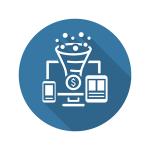
When sales reps look to the new year, they probably think about the new customers they hope to win, rather than how the tools they use will change. Yet the future of CRM could wind up having a lot to do with how they’ll grow their base in 2016.
For example, a recent article on CIO.com offered six predictions on CRM’s evolution. These included CRM that made much better use of social media, CRM that is more predictive and more tied to smart devices that make up the Internet of Things. They were all thought-provoking, even inspiring ideas, but they’re not the only possibilities.
This is a great time of year to take a moment and really do a bit of “blue sky” brainstorming. How might CRM change in the long term to maximize the value it brings to sales teams, and to small and medium-sized businesses overall? How far can you let your imagination take you? Here are a handful of ways to get started:
Wearable CRM
While 2015 marked the year Apple debuted its Apple Watch, 2016 could become known as the year when enterprise wearables really being to take off. Enterprise wearables (which really mean “designed for business use,” and therefore appropriate for SMBs as well) could come in many shapes and sizes, from smart watches to eyewear and all kinds of other devices. It could mean new ways that sales reps on the go could get access to changes or updates in CRM. Think about a rep walking into a meeting who could simply glance at their smartwatch or look through smart glasses to see a customer’s account history, rather than scrolling on their smartphone or tablet. It could redefine what “mobile computing” really means. This technology is already here today, and is probably destined for much wider adoption over the next few months.
Virtual Reality CRM
When Facebook bought Oculus Rift earlier this year, the consumer electronics industry was lit up by the thought of how virtual reality could make playing video games more immersive and enjoyable. The potential applications of VR for business are still in their early days, but think about how CRM is traditionally used to help sales teams get to know their best customers as intimately as possible. VR could be tied to CRM data to help create new kinds of virtual meetings between sales professionals and customers in far-off locations, sort of like the way the best sales teams are beginning to make use of video as a sales tool today.
CRM Simulations
To some extent, selling is really about trying to help customers see a positive version of what their future could look like if they invest in specific products and services. Particularly in the B2B space, that increasingly means using data in more visually compelling ways. Imagine someone selling into the health-care market, for instance, who would create a simulation online that showed how purchasing new equipment could change the way an operating room is run, or a simulation that showed a bank how new ATMs would speed up their customers’ ability to make withdrawals. Advanced simulations and data visualizations of the future will inevitably need to draw on the purchase histories, company sizes and other information that’s stored in CRM, unleashing it in highly engaging ways.
User-Generated CRM
So much of CRM today involves sales agents putting data into the system, whether it’s after a meeting, a cold call or an interaction on social media. Over the past few years, however, customers have started connecting with their peers in online communities where they discuss common challenges, share best practices and provide valuable feedback to their vendors. It may not be long before the most thoughtful insights from these communities become one of the major inputs to CRM systems of the future – a way for customers to more directly nurture relationships with their best suppliers, and not just the other way around.
AI-based CRM
Robots are not about to replace sales teams anytime soon, but the artificial intelligence (AI) baked into CRM is undoubtedly going to become more sophisticated. This started in 2015 with SalesforceIQ, but expect to see more intelligent assistants and other tools that help sales reps get even more out of CRM than they do today. These CRM tools will behave much like the best sales pros, by offering teams information and insights about prospects and customers without even being asked.
Of course, no one can be completely certain about what CRM will look like over the long term, but there’s no doubt it will become even more critical for sales teams’ success in 2016.
Learn how to put your customers at the heart of your business with Salesforce’s CRM or take a look at it in action here.


























